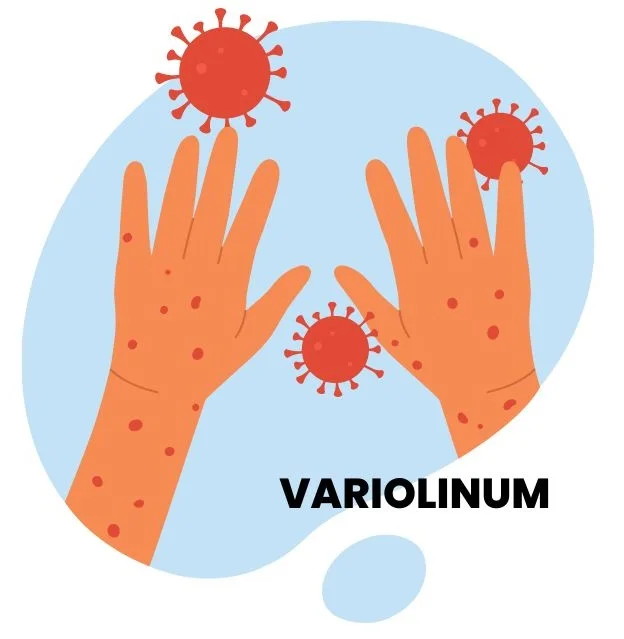Variolinum is a homeopathic remedy prepared from the lymph of smallpox pustules.
It is primarily used for prophylaxis (preventive treatment) against smallpox and has been utilized in homeopathy as an “internal vaccination” to either protect against, modify, or aid in the treatment of smallpox.
Though smallpox has been eradicated, Variolinum remains relevant in the homeopathic Materia Medica for its role in preventing diseases similar to smallpox and addressing certain skin and fever-related symptoms.

Table of Contents
ToggleSOURCE INFORMATION
Origin
- Variolinum is prepared from the lymphatic fluid derived from the pustules of smallpox.
- Historically, this fluid has been used in both conventional and homeopathic medicine to create vaccines and remedies aimed at preventing and treating smallpox.
Historical Facts
- Variolinum has been used in homeopathy for its prophylactic effects against smallpox and for mitigating the severity of symptoms in infected patients.
- It has also been considered in cases where patients suffer from lingering effects after vaccination or other diseases with similar symptoms.
DRUG PATHOGENESIS
- Variolinum’s primary action is to help the body build resistance against smallpox or to modify the disease’s impact if contracted.
- It also addresses a range of feverish conditions, pustular eruptions, and respiratory issues associated with smallpox-like diseases.
- The remedy is also indicated in cases of fear of infection, particularly regarding smallpox or other serious contagious diseases.
PHYSICAL CONSTITUTION
- Variolinum is best suited to individuals prone to fevers, skin eruptions, and respiratory infections.
- These patients may exhibit signs of general weakness, restlessness, and symptoms affecting the nervous system due to prolonged illness.
DIATHESIS
- It is particularly indicated for individuals who have a predisposition to eruptive or contagious diseases, including those with a history of exposure to smallpox or similar viral infections.
TEMPERAMENT
- These individuals may experience morbid fears, especially related to illness or infection, and often feel weak, tired, and restless.
KEY CHARACTERISTICS
- Fear of Smallpox: One of the key mental symptoms is a morbid fear of contracting smallpox or other serious diseases.
- This can manifest as anxiety, paranoia, and restlessness in individuals concerned about their health or the risk of infection.
- Pain and Weakness: Variolinum is indicated for excruciating back pain, aching in the legs, and generalized body pain with a feeling of tiredness.
- Patients often feel restless yet exhausted, with shifting pains that move from the back to the abdomen.
- Skin Eruptions: The remedy addresses pustular eruptions and skin conditions like shingles, which involve hot, dry skin and painful, blister-like eruptions.
- This symptom mirrors the characteristic pustules seen in smallpox.
- Fever and Sweating: Patients may experience a high fever with intense radiating heat and profuse, offensive-smelling sweat.
- This can occur alongside feverish skin that feels dry and hot.
DETAILED ORGAN SYMPTOMS
HEAD
- Morbid fear of smallpox or other infections.
- Pain in the occiput (back of the head), often accompanied by deafness.
- Inflamed eyelids, with redness and swelling, mirroring symptoms seen in viral infections.
RESPIRATORY SYSTEM
- Oppressed breathing, with a feeling of tightness in the throat.
- Thick, viscid, bloody mucus is often coughed up, indicative of serious respiratory involvement.
- Sensation of a lump in the right side of the throat, leading to discomfort when swallowing.
MUSCULOSKELETAL SYSTEM
- Excruciating backache that may worsen with movement or physical activity.
- Aching in the legs and pain in the wrists, often accompanied by generalized weakness and a feeling of being tired all over.
SKIN
- Pustular eruptions similar to smallpox or shingles, causing the skin to feel hot, dry, and irritated.
- May help in treating shingles or other viral eruptions, characterized by blistering pustules.
FEVER
- Hot fever with intense radiating heat and profuse sweating.
- The sweat is often bad-smelling, and the fever may cause extreme discomfort.
MODALITIES
Worsening Conditions
- Symptoms worsen with restlessness, exertion, or mental agitation.
- Pain and fever tend to intensify during nighttime or after exposure to cold air.
Amelioration
- Symptoms improve with rest, warmth, and hydration.
- Skin eruptions and pain may ease with cool applications or after eruptions have fully developed.
WHAT ARE MODALITIES IN HOMOEOPATHY?
RELATIONSHIP WITH OTHER DRUGS
Compare with,
- Vaccin (another remedy related to vaccination effects, particularly for smallpox).
- Malandrinum (prepared from the morbid product of the grease of a horse, used as a prophylactic for smallpox and for treating the aftereffects of vaccination, including chronic eczema).
Antidotes,
- Malandrinum is often used for the ill effects of vaccination, such as chronic skin conditions or eczema that follow after smallpox vaccination.
DOSE
- Variolinum is typically prescribed in 6th to 30th potency, depending on the severity of the symptoms and the individual case.
- Higher potencies are often used in cases of prevention or for treating long-term sequelae of diseases.
Frequently Asked Questions (FAQs)
What is Variolinum used for in homeopathy?
- Variolinum is primarily used as a preventive and curative remedy for smallpox and diseases with similar symptoms, such as shingles or other pustular eruptions.
Can Variolinum prevent smallpox?
- Yes, in homeopathic practice, Variolinum is used for internal vaccination, believed to protect against smallpox and to modify the disease’s course if contracted.
How is Variolinum different from Vaccin?
- Vaccin is also used for conditions following vaccination, but Variolinum is specifically prepared from the smallpox pustules and is more closely aligned with smallpox-related symptoms and its prevention.
Can Variolinum treat shingles?
- Yes, Variolinum can be used to treat shingles, particularly when the eruptions resemble pustules and there is fever and pain associated with the condition.
Glossary of Difficult Words
- Prophylaxis: Preventive treatment aimed at protecting against disease.
- Viscid: Thick, sticky consistency, often referring to mucus.
- Pustular Eruptions: Blister-like skin eruptions filled with pus.
- Sequelae: Long-term consequences or aftereffects of a disease.
